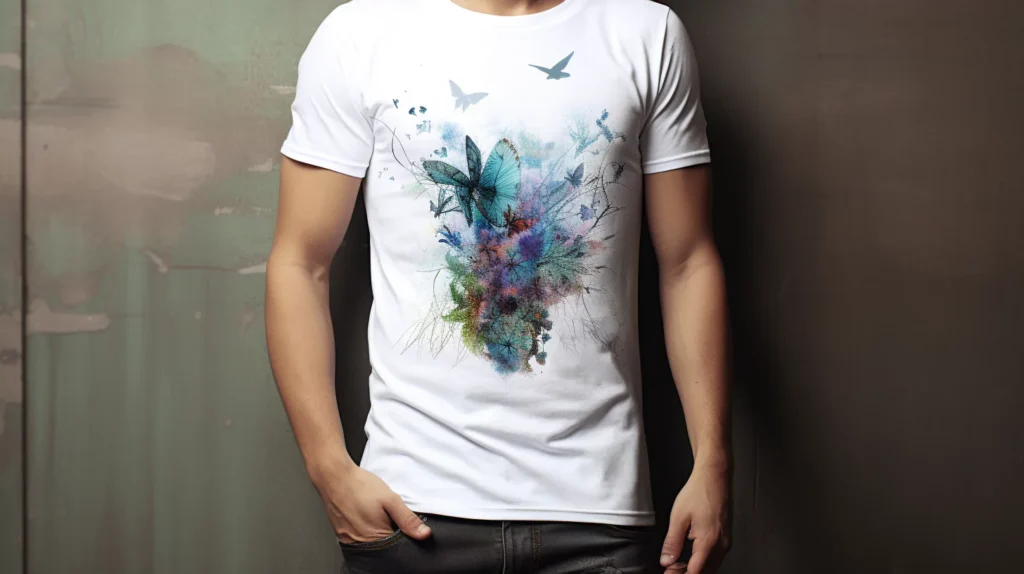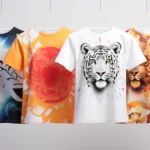Sublimation printing has exploded in popularity for customizing blank items like shirts, phone cases, tiles, and more. But as the technique spreads, so do concerns around traditional sublimation inks. Many standard inks contain hazardous volatile organic compounds (VOCs), toxic solvents, and heavy metals that threaten environmental and human health.
Luckily, eco-conscious alternatives have emerged that reduce waste and emissions without sacrificing vibrant, customize designs. This guide explores those sustainable sublimation options for creators and businesses seeking to minimize their footprint.

What Exactly is Sublimation Printing?
For the uninitiated, sublimation transfers dye into blanks like fabrics, ceramics, and plastics by turning ink temporarily into a gas. Printers first lay out the designs on special sublimation transfer paper. Heat presses then convert the ink into vapor, which diffuses into polymers in the blank item. As it cools, the gaseous dye solidifies again as a permanent, high definition print embedded in the object’s surface. The results far surpass ordinary printing.
That alchemical process leaves room for creativity, customizing tiles, shot glasses, phone grips and much more. But traditional petroleum-based inks taint sublimation’s magic. Harsh solvents endanger workers while vapors off-gas volatile organic compounds (VOCs) linked to cancer and smog formation. The inks also leach heavy metals like chromium and nickel. Reckless discharge of used cartridges could contaminate soil and critical waterways. Industry innovators recognized sublimation printing’s need for safer, environmentally-friendly inks.
Eco-Friendly Sublimation Inks Emerge
The last decade witnessed rising consumer demand for ethically-sourced, non-toxic sublimation ink made with renewable ingredients. Manufacturers answered that call, developing new water-based inks devoid of harmful VOCs and heavy metals. Brands like Green Galaxy, TexPrint and others lead the way with specialized eco-sublimation cartridge lines. Their revolutionary products maintain the color brilliance and seamless transfer that makes sublimation shine.
By ditching petroleum carriers in favor of vegetable oils, glycerin or other natural solvents, these biodegradable sublimation inks lower disposal impacts. Responsible consumers should still recycle cartridges properly. But the reduced health risks and emissions give eco-conscious companies powerful incentives to make the eco-switch. Many printers house the new aqueous inks in partially plant-based cartridges built with bioplastics or recycled materials for further sustainability. As R&D continues, future generations of green sublimation ink will stretch bio-content even further while optimizing performance metrics like transfer efficiency.
| Benefits of Eco-Sublimation Inks |
|---|
| Improved indoor air quality and safety |
| Lower VOCs and environmental impacts |
| Enhanced branding via sustainability practices |
| Inexpensive to operate with tax incentives |
| Guilt-free use of vibrant sublimation techniques |
Key Buying Considerations for Eco-Inks
Eco-friendly sublimation shows great promise, but varies between formulations. Conscientious creators should weigh key factors when selecting the right sustainable ink.
Print Quality
Some ‘greener’ inks still lag behind petroleum counterparts’ color intensity, especially darker hues. But test different brands across your common substrates. Many offer exceptional results rivaling standard inks. Prioritize for your needs.
Material Compatibility
Ensure any new ink works well on your typical blanks. Most eco-options readily infuse popular polyester fabrics and ceramic coatings. But test niche substrates beforehand if possible to confirm performance.

Cost
At roughly $1-3 more per cartridge, leading VOC-free sublimation inks cost moderately more than traditional inks. Factor possible savings via workplace safety, energy and waste reduction. Many governments offer tax incentives for verified sustainable supply chains too.
Third Party Verification
Watch for labels like OEKO-TEX® Standard 100 or UL ECOLOGO® to confirm reduced environmental impacts from reputable verifiers. But don’t assume sustainability just from ‘eco’ branding claims alone. Ask reps for data-backed specifics.
Tips for Maximizing Sustainability With Eco-Inks
Choosing non-toxic sublimation ink marks a major step toward ethical design. But that’s only part of sublimation’s supply chain. Here are ways to enhance the sustainability of the entire process:
Optimize Ink Efficiency
Avoid underfilling or oversaturation of cartridges. Design prints strategically to minimize waste ink on transfer sheets. Used properly, a little eco-ink goes a long way.
Recycle Empty Cartridges
Responsibly return depleted ink cartridges for recycling following regional guidelines. Certain print shops will collect empties for batch reprocessing. Don’t simply discard bio-inks down the drain.
Choose Sustainable Blanks
Pair the eco-ink with recycled polyester, organic cotton or other eco-friendly sublimation blanks. Support providers shifting textiles and ceramics toward renewable sources. Vote for the full package.
The world of sublimation printing still has room for improvement. But water-based dyes sans VOCs or heavy metals make that colorful process safer for workers and ecosystems alike. As innovators like Green Galaxy pioneer better formulations and new bio-sublimation inks, creative businesses have many reasons to make the eco-switch today. What sustainable sublimation option will you try first?
Frequently Asked Questions About Eco-Sublimation Inks
Is the print quality the same with eco-friendly sublimation inks?
Print vibrancy and color accuracy varies between different eco-ink formulations. Leading aqueous inks rival petroleum-based inks, especially on white or light colored blanks. But some plant-based inks still struggle producing deep blacks or bright neon tones. Test samples first whenever possible. Performance improves constantly.
How much more expensive is eco-friendly sublimation ink?
Expect to pay $1-3 more per cartridge for most eco-friendly brands. But reduced health risks and proper waste disposal costs offset some of that premium. Many workplaces save significantly by improving air quality too. Eco-conscious positioning can also boost sales.
Can you reuse sublimation transfer sheets with eco-ink?
In general, no – even with aqueous inks, transfer sheets are still single-use. Attempting a second press risks scorching, uneven designs or time-wasting misprints. Protect your blanks and reputation by using fresh sheets. Sustainable sublimation is about holistic impact reduction, not cutting corners.
What are common certifications to look for with eco-inks?
Credible eco-sublimation brands validate their reduced environmental impacts through labels like:
- OEKO-TEX® Standard 100 – Confirms safer textile components
- GREENGUARD Gold – Strict indoor air quality criteria
- UL ECOLOGO® – Multi-attribute sustainability certification
- USDA BioPreferred® – Validates bio-based content claims
- Energy Star – Strict energy efficiency specifications
Independent, data-backed labels indicate rigorous testing and verification. They’re more reliable than generic ‘eco’ self-claims alone when comparing products.




